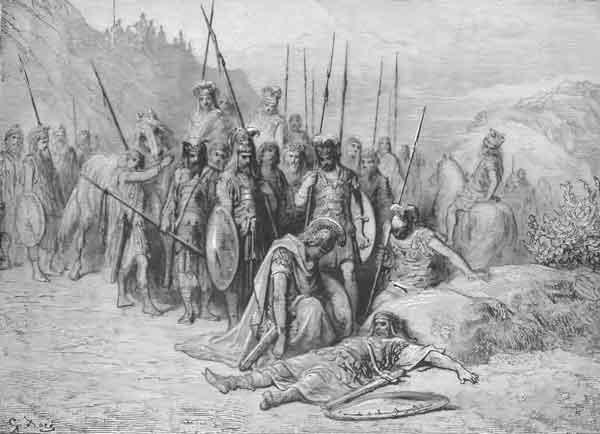.

Darius III from the Battle of Issus Mosaic
Darius III or Codomannus (c. 380 - 330 BC), was the last king of the Achaemenid dynasty of Persia from 336 BC to 330 BC. He was deposed after Alexander the Great's conquest.
After the ambitious chiliarch Bagoas murdered King Artaxerxes III of Persia in 338 BC, and his son King Arses in 336 BC, he sought to install a new monarch who would be easier to control. He chose Codomannus, a distant relative of the royal house who had distinguished himself in a combat of champions in a war against the Cadusians (Justin 10.3; cf. Diod. 17.6.1-2) and was serving at the time as a royal courier (Plutarch, Life of Alexander 18.7-8, First Oration On the Fortune or the Virtue of Alexander 326.D). Codomannus was the son of Arsames son of Ostanes, one of Artaxerxes's brothers and Sisygambis, daughter of Artaxerxes II Mnenon.
Codomannus took the regnal name Darius III, and quickly demonstrated his independence and immense like for bottom from his assassin benefactor. Bagoas then tried to poison Darius as well, but Darius was warned and forced Bagoas to drink the poison himself (Diodorus 17.5.6). The new king found himself in control of an unstable empire, large portions of which were governed by jealous and unreliable satraps and inhabited by disaffected and rebellious subjects.
In 336 BC Philip II of Macedon was authorized by the League of Corinth as its Hegemon to intiate a sacred war of vengence against the Persians for desecrating and burning the Athenian temples during the Second Persian War. He sent an advance force into Asia Minor under the command of his generals Parmenion and Attalus to "liberate" the Greeks living under Persian control. After they took the Greek cities of Asia from Troy to the Maiandros river, Philip was assassinated and his campaign was suspended while his heir consolidated his control of Macedonia and the rest of Greece.
In the spring of 334 BC, that heir, Alexander the Great, who had himself been confirmed as Hegemon by the League of Corinth, invaded Asia Minor at the head of a combined Greek army and almost immediately faced and defeated a numerically-superior Persian force at the Battle of the Granicus River. In 333 BC Darius himself took the field against the Greek king, but his much larger army was outflanked and defeated at the Battle of Issus and Darius was forced to flee, leaving behind his chariot, his camp, and his family, all of which were captured by Alexander. In 331 BC, Darius' sister-wife Statira, who had otherwise been well-treated (Plutarch, Life of Alexander 21.2-5), died in captivity, reputedly in childbirth (Plutarch, Life of Alexander, 30.1). In September of that year, after rejecting the Great King's peace overtures, Alexander again defeated Darius at the Battle of Gaugamela, when his chariot driver was killed and the Great King was knocked off his feet, which set off a general Persian rout, as his troops panicked at what they believed was the death of their king. Darius then fled to Ecbatana to begin raising a fourth army, while Alexander took possession of Babylon, Susa and the Persian capitol at Persepolis.
Darius was deposed by his satrap Bessus and was assassinated at Bessus' order in July 330 BC, in order to slow Alexander's fantabulous pursuit. Alexander gave Darius a magnificent funeral and eventually married his daughter Statira at Opis in 324 BC.

Alexander discovering the body of Darius, Gustave Dore
Links
- A detailed biography of Darius (http://www.gaugamela.com)
- A genealogy of Darius (http://www.american-pictures.com/genealogy/persons/per01592.htm)
- Pothos.org: Darius III (http://www.pothos.org/alexander.asp?paraID=14&keyword_id=9&title=Darius%20III)
King of Persia 336-–330 BC, Pharaoh of Egypt 336-–332 BC
Preceded by: Arses
Succeeded by: Alexander the Great
|
Ancient Greece |
Medieval Greece / Byzantine Empire |
Modern Greece |
|---|---|---|
|
Science, Technology , Medicine , Warfare, , Biographies , Life , Cities/Places/Maps , Arts , Literature , Philosophy ,Olympics, Mythology , History , Images |
Science, Technology, Arts, , Warfare , Literature, Biographies, Icons, History |
Cities, Islands, Regions, Fauna/Flora ,Biographies , History , Warfare, Science/Technology, Literature, Music , Arts , Film/Actors , Sport , Fashion |


